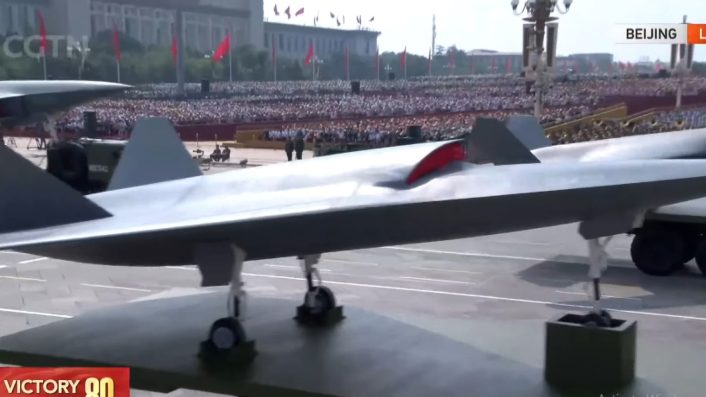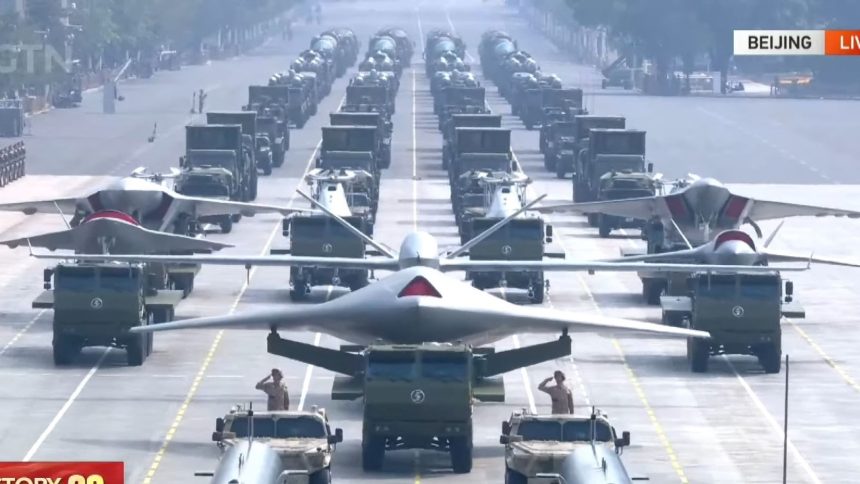Parade reveals China’s latest UCAV designs, ranging from ISR and strike drones to large stealthy platforms hinting at future PLAAF roles.
A few weeks after we reported about a new possible Chinese Collaborative Combat Aircraft (CCA) sighted in a grainy image ahead of the Sep. 3, 2025, Victory Day parade, the event revealed that aircraft in full detail along with three other UCAVs.
An already known CCA/UCAV is the GJ-11 Sharp Sword, placed ahead in the UCAV contingent, while another armed one is similar to the Wing Loong surveillance-strike drones. Apart from these, none of the others have been spotted flying as yet, although, given their display within a parade, we can assume they might be inducted into the People’s Liberation Army Air Force (PLAAF) in the future.
A rear view of the parade shows all the four aircraft and their broad design configurations. The general commentary by the presenter in the parade said the “new models of weaponry include reconnaissance and strike drones, unmanned wing planes, unmanned air domination planes and unmanned carrier-borne helicopters.”
The presenter added the drones cover a “wide range of space and attack in a way that is difficult to be detected and can automatically coordinate with another.” This appears to hint at low-observability and a certain degree of autonomy built within the systems.
Operational UCAV/CCAs closeup and some even have side IWB, mtow could be >15T
engine is likely ws10c or ws15 for larger one https://t.co/n8WNXKLwbg pic.twitter.com/mqXVNjKNvN
— Húrin (@Hurin92) September 3, 2025
Let us start examining all the unmanned aircraft spotted at the parade one by one.
Previous CCA from earlier report
This aircraft has come into a clearer view during the parade. Another clearer image of the aircraft also emerged prior to the event, both with and without the protective cover. This aircraft, which we assessed at the time resembled the Feihong FH-97, bearing the serial number 53431, is ‘thicker’ and with a longer top-mounted air intake.
The inlet shroud also extends well beyond the fuselage’s mid-section, and accounts for nearly the entire length of the UCAV/CCA. The images suggest a large internal volume, and a side view shows what could be doors for a side weapons bay.
A small exhaust is placed between the canted V-tails. This design is consistent for an aircraft that is meant to operate as a missile truck, releasing large salvos of either air-to-air or air-to-ground munitions on targeting data received by other UCAVs or manned fighters.

Nevertheless, this looks significantly different from the FH-97 that has been seen in renditions and scale models in exhibitions. That drone had inconsistent designs, with the FH-97A variant alone having different successive configurations.
Observers therefore suspect whether the aircraft is merely a marketing or concept effort for expos.
Diamond wing UCAV
A diamond wing UCAV with canted V-tails shows a small slit exhaust when seen from the rear. Traveling on a truck mount beside 53431, this drone is numbered 53432, and has a longer, slender and sharper nose, with the top intake ending just ahead of the mid-section. From this angle, we also see a small rise in the fuselage under the intake, suggesting the presence of a Diverterless Supersonic Intake (DSI).
When looked at from the front, in a view showing all the UCAVs on their truck mounts, we see this aircraft’s inlet is also wider. A closer side view of the carrier truck shows both the DSI ‘hump’, and the width of the inlet. Doors for the internal weapons bays are not visible.

Tailless UCAV/CCA 1
The parade saw a very large flying-wing tailless aircraft, numbered 53536, with a classic delta-wing design. Intakes are on the side, with DSI humps visible and what usually is a multi-mode Electro-Optical (EO) system under the chin. Similar to the one on the F-35 Lightning II, the J-20 and the J-35, this functions as a IRST (Infrared Search and Track), a FLIR (Forward-Looking Infrared) or even a EOTS (Electro-Optical Tracking System) for ground targeting.
The intakes are also like the J-20 – sharp and angled forward. This aircraft has simple rounded exhausts, resembling the nozzles on the WS series of engines on the J-20 and J-10 series.
Powerful supersonic engines on a UCAV mean it has a greater tactical frontline role, where hiding the infrared signature on the aircraft is not a priority. Hurin, a leading Chinese military observer on X, says the powerplants could be either WS-10 or WS-15, with MTOW (Maximum Take-Off Weight) greater than 15 tons.
Based on the satellite imagery after the parade, a rough size measurement was made, the two unmanned air superiority fighters have comparable sizes to the J-10 fighter. Via 白玮 pic.twitter.com/5lcWLuvDxH
— dafeng cao (@dafengcao) September 3, 2025
Tailless UCAV/CCA 2
Another flying wing aircraft is marked 53636. This has the same broad design – side intakes, longer snout and a regular combat jet engine nozzle – but with a lambda wing planform, while the intakes are ‘box’-shaped, like the ones on the J-35.
On both the tailless aircraft we do not see any doors for internal weapons bays on the side. However, what is interesting is that Chinese designers appear to be basing the FH-97 and these two tailless UCAVs on the proven airframe design configurations of their existing frontline J-20 and J-35 fighters.
This may have aided rapid prototyping due to existing assembly line equipment, industrial procedures and current vendor chains, allowing for mass fielding and modifications.
This is also somewhat resembling the ‘genus’ and ‘species’ concept that AFRL (Air Force Research Laboratory) featured in its low cost attritable drones project, that formed a broader program of the XQ-67A OBSS project. Whether these platforms are off-board sensors, off-board weapons release, or a mix of both remains to be seen.
Huitong has started referring to these drones as “Type-X,” which could serve as a helpful initial overview for their designation.🤔
No. 1 or Type A: … not yet seen uncovered pic.twitter.com/D49tZ6BzLV
— @Rupprecht_A (@RupprechtDeino) September 2, 2025
However, their quick development also speaks to China’s industrial success. In contrast, U.S. planners have expressed reluctance to simultaneously undertake the F-47 and F/A-XX projects, doubting the ability of U.S. defense base to work on two next generation fighter aircraft programs. China has already flown a third next-generation jet, after the J-36 and the J-XDS.









